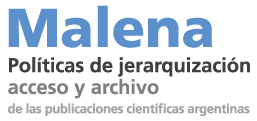Municipal environmental management in Neuquén: institutional capacities and current challenges.
Keywords:
Environmental Management, Municipalities, NeuquénAbstract
Municipalities, as local territorial units, have undergone changes in their functions and responsibilities since their recognition as administrative entities in the national constitution. These changes include new functions that modern societies increasingly demand from their governments, such as public safety, culture, and recreation—complementing the basic services that municipalities have traditionally provided. In this context, environmental issues have progressively gained visibility on the local agenda, although their incorporation has not been uniform or without challenges. This article aims to analyze how municipalities in the province of Neuquén have integrated environmental functions into their institutional structure, considering their actual capacities, available regulatory frameworks, and the practices developed in each territory. Using a comparative approach and based on interviews with environmental managers, the study seeks to identify both structural constraints and emerging local strategies that shape the current landscape of municipal environmental management. The article is structured in three sections: a general review of the environmental role of local governments in Argentina; an analysis of Neuquén’s municipalities in terms of institutional capacities and environmental management; and a final reflection on the current challenges to strengthening the environmental role of local governments.
Downloads
References
AIN, (2015). Agencia De Inversiones Del Neuquén. Gestión Integral de los Residuos Sólidos Urbanos en la región de los Valles y la Confluencia. Recuperado de: http://adinqn.gov.ar/presentaciones/GIRSU_concejales.pdf.
Ambrosio, M. (2005). Conceptos generales sobre Ambiente. En Atlas Temáticos Ambiental de Neuquén y Río Negro. Fascículo 6. Editorial Río Negro. General Roca. Río Negro. Argentina
Arroyo, D. (2001). Las microregiones como instrumentos para el desarrollo local en Argentina. VI Congreso Internacional del CLAD sobre la Reforma del Estado y de la Administración Pública, Buenos Aires, Argentina. Pag: 1-5.
Cañas, C. (2006). Manejo de vertidos líquidos. En Marroquín, W. Herramientas para la gestión ambiental y territorial de municipalidades. CICOP. San Salvador, El Salvador. C.A.
Cao, H. (2008). La administración pública argentina: nación, provincias y municipios. XIII Congreso Internacional del CLAD sobre la Reforma del Estado y de la Administración Pública, Buenos Aires, Argentina.
INDEC (2010). Censo Nacional de Población, Hogares y Viviendas 2010. Instituto Nacional de Estadística y Censos. https://www.indec.gob.ar/indec/web/Nivel4-Tema-2-41-135
INDEC (2022). CNPHyV, Censo Nacional de Población, Hogares y Viviendas 2022. Resultados provisionales. Instituto Nacional de Estadística y Censos. https://www.indec.gob.ar/indec/web/Nivel4-Tema-2-41-165 (2022).
Chévez, N. (2006). Comunicación y educación ambiental. En Marroquín, W. Herramientas para la gestión ambiental y territorial de municipalidades. CICOP. SanSalvador, El Salvador. C.A.
Cravacuore, D. (2007). Los Municipios Argentinos (1990-2005). En Procesos políticos comparados en los municipios de Argentina y Chile: 1990-2005. coordinado por Daniel Cravacuore y Ricardo Israel - 1a ed. Bernal: Univ. Nacional de Quilmes: Universidad Autónoma de Chile, 2007.
DPEyC, (2018). Dirección Provincial De Estadística y Censos de la provincia del Neuquén. Información Municipal Básica de la provincia del Neuquén.
Espinoza, G.; (2007). Gestión y Fundamentos de Evaluación de Impactos Ambientales. CAPITULO V. Importancia de la información para la EIA. Banco Interamericano de Desarrollo (BID) y Centro de Estudios para el Desarrollo de Chile (CED). Santiago de Chile.
Jaramillo, J. (1999). Gestión integral de residuos sólidos municipales (GIRSM) Seminario Internacional Gestión Integral de Residuos Sólidos Peligrosos, Siglo XXI. Medellín.
López Accotto, A., & Macchioli, M. (Coords.). (2015). La estructura de la recaudación municipal en la Argentina: alcances, limitaciones y desafíos. Universidad Nacional de General Sarmiento – Secretaría de Asuntos Municipales del Ministerio del Interior. ISBN 978-987-630-217-3.
López Alfonsín, M. y Martínez, A. (2010). La cláusula ambiental y la autonomía municipal en la Constitución neuquina reformada. En Iglesias, A. y Martínez, A. Desarrollo Territorial Sostenible: instrumentos participativos para la acción. Educo Universidad Nacional del Comahue. Neuquén.
Lozupone, M. (2019). La gestión de los residuos sólidos urbanos en los municipios argentinos: Un estudio desde la economía circular hacia la sustentabilidad integral. Buenos Aires: Fundación CECE.
Maceira, D., Olaviaga, S., Fernández Arroyo, N. y Boix, M. V. (2010). El papel de los municipios en la inversión pública social en infancia y adolescencia: Resultados de una encuesta nacional a municipios argentinos. Buenos Aires: CIPPEC – UNICEF.
Massolo, L. (2015). Gestión ambiental y desarrollo sostenible aspectos generales. En: Massollo, L. (Coord.) Introducción a las Herramientas de Gestión Ambiental. EDULP.
MAyDS, Ministerio de Ambiente y Desarrollo Sustentable de la Nación. (2017). Informe del Estado del Ambiente 2017. Buenos Aires: Presidencia de la Nación. Recuperado el 1 de junio de 2024. https://www.argentina.gob.ar/ambiente/estadodelambiente.
Muriel, R. (2006). Gestión Ambiental. En Ideas Sostenibles. Espacio de reflexión y comunicación de desarrollo Sostenible. Año 3 Número 13. Asociación Ide@sostenible. ISSN: 1887- 2379. Recuperado de: http://upcommons.upc.edu/revistes/bitstream/2099/1110/1/13_GestAmbientalRafaelMuriel_cast.pdf el 1 de junio de 2024.
Pérez, G. (2018). La conurbación en torno a la ciudad de Neuquén. Perspectiva regional y aportes para el ordenamiento territorial (Tesis de Doctorado en Geografía). La Plata, Universidad Nacional de La Plata. https://www.memoria.fahce.unlp.edu.ar/tesis/te.1583/te.1583.pdf
Sáez, A; y Urdaneta J, A. (2014). Manejo de residuos sólidos en América Latina y el Caribe. Omnia, vol. 20, núm. 3. pp. 121-135 Universidad del Zulia Maracaibo, Venezuela.
ONU, (2018), (2018, 8 de octubre). Un informe de la ONU sobre cambio climático pide acciones "urgentes y sin precedentes" para frenar el calentamiento global. Noticias ONU. https://news.un.org/es/story/2018/10/1443562
Published
How to Cite
Issue
Section
ARK
License
Copyright (c) 2025 Boletín GeográficoTransfer of rights and data processing
The acceptance of an article for publication in the Journal Geographic Bulletin implies the cession of the rights of printing and reproduction, by any means and means, of the author in favor of the Department of Geography of the National University of Comahue, which will not reject any request reasonable for the authors to obtain permission to reproduce their contributions. The total or partial reproduction of the works published in the Geographic Bulletin must be done citing the origin, otherwise, the copyright is violated.
Likewise, it is understood that the concepts and opinions expressed in each work are the sole responsibility of the author, without being responsible or in solidarity, necessarily, neither the editorial staff nor the editorial staff.
It is the responsibility of the authors to be able to provide interested readers with copies of the raw data, procedure manuals, scores and, in general, relevant experimental material.
Likewise, the Management of the journal guarantees the appropriate treatment of personal data
COPYRIGHT TRANSFER FORM

















 Journal of the
Journal of the 